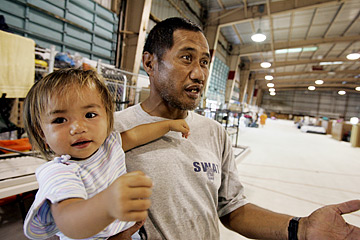
FL MORRIS / FMORRIS@STARBULLETIN.COM
Lloyd Saltiban, holding his daughter Michelle, talks about his struggle with poverty in the Kakaako homeless shelter Next Step. Saltiban, who earns $10.75 an hour as a maintenance man, supports a family of four, and has been homeless for most of the 27 years since he moved to Oahu from Maui.
|
|
Fewer in Hawaii living in poverty
The state has the seventh-lowest rate nationally, and ranks fourth for income
Holding his year-old daughter, Michelle, in his arms at the state's homeless shelter in Kakaako, Lloyd Saltiban said he could believe more people in Hawaii are making it out of poverty.
Yet, it's still a struggle for him to support his family of four on the $10.75 an hour he makes as a maintenance man.
LESS POVERTY
Hawaii's 2005 rankings:
Poverty rate
Hawaii: 9.8 percent, seventh-lowest in the nation
U.S. average: 12.6 percent
No health insurance coverage
Hawaii: 9.5 percent, second-lowest in the nation
U.S. average: 15.9 percent
Median income
Hawaii: $58,402, fourth-highest in the nation
U.S. average: $46,326
Source: U.S. Census Bureau
|
A Census Bureau report released yesterday reported that 9.8 percent of Hawaii's population -- about 110,000 people -- live below the poverty level, a slight decrease from 2000, when 10.7 percent lived in poverty. Hawaii has the seventh-lowest poverty rate in the nation.
The Census Bureau surveyed 100,000 households in the spring about their incomes and health insurance in 2005.
The report also shows Hawaii and Minnesota with the lowest percentage of uninsured. But the number of people without health insurance still rose 2.9 percent between 2004 and 2005.
Saltiban said he and his family have medical insurance through the state's Quest program, unlike an estimated 116,000 people in Hawaii who do not have insurance.
Using a three-year average, the Census Bureau reported about 9.5 percent of Hawaii's residents are without health coverage, compared with 8.7 percent for Minnesota -- statistically even, the bureau said.
Hawaii's median income was $58,112 last year. But buying power in the state was down slightly from 1999, when the median income was $58,402, adjusted for inflation.
But median income in Hawaii was up 4 percent when comparing the two-year average of 2003-2004 and 2004-2005.
The state had the fourth-highest median income in the nation, below New Jersey, Connecticut and Maryland.
Sylvia Yuen, director of the University of Hawaii at Manoa's Center on the Family, is not surprised at the household income median in Hawaii, especially since the state's economy is improving.
However, Yuen said her research shows a family of four living in Honolulu needs to make about $55,000 to pay for rent, transportation, food and other necessities.
"For many people, although their salaries may have gone up, they're still struggling economically just to meet the basic family needs," Yuen said.
Saltiban, who said he has been homeless for most of his life since moving to Oahu from Maui in 1979, is on the waiting list for subsidized housing. But he said even a reduced rent of $400 will be a struggle every month.
In many families, both parents work, sometimes with multiple jobs, and more than one family may live together, which adds to household income, Yuen said.
State Human Services Director Lillian Koller said the state got a $100 million federal grant in February, which should bring down further this year the number of people without insurance.
Koller said the reduction in poverty in Hawaii is not surprising, because her department has been aggressively pushing a number of programs to get people off welfare and prevent poverty. The strong economy and labor shortage also help, she added.
Nationwide, household incomes edged up slightly in 2005, but 37 million people were still living below the poverty line, about the same as the year before.
The last decline in the poverty rate was in 2000, during the Clinton administration, when it dropped to 11.3 percent.
The official poverty level is used to determine eligibility for federal health, housing, nutrition and child care benefits. The poverty rate -- the percentage of people living below poverty -- helps shape the debate on the health of the nation's economy.
The poverty level differs by family size and makeup. For example, the poverty level for a family of four was $19,971 last year. For a family of two, it was $12,755.
About 12.6 percent of the population lived below the poverty line in 2005.

